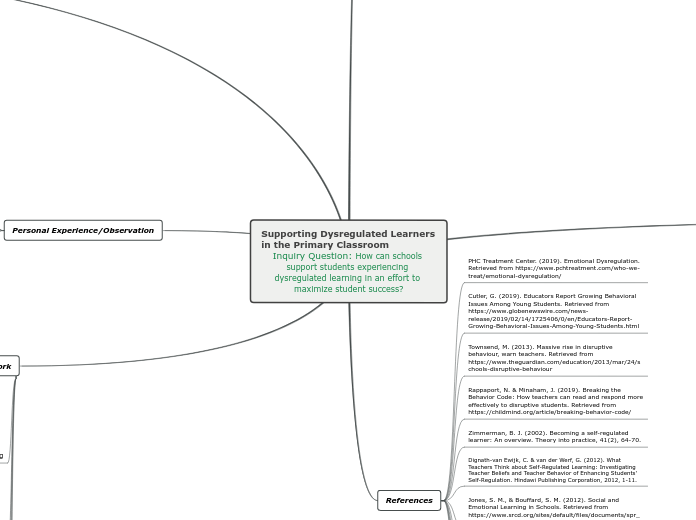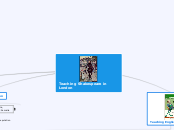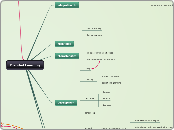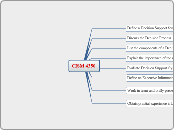Supporting Dysregulated Learners in the Primary Classroom Inquiry Question: How can schools support students experiencing dysregulated learning in an effort to maximize student success?
Connection to Coursework
The Connected Classroom
Examination of home/school connections influencing dysregulation
Technology component
Community
Impprtnace of home/school connection
Startegeies for parents
Inncative Cuuriculum Planning
Application of contemporary curriculum and instructional innovations to help meet need of dysregulated learners
Experiential Learning
Inquiry Based Learning
Outdoor Education
STEAM
Flipped Classroom
Maker Education
Organizational Learning
Application of four frames thinking (structural, human, political, symbolic) in format presentation
Organizational Leadership
Application of social and cultural construction of leadership to look at roles and responsibilities that an administrator has within the construct of dysregulated learners and disruptions in learning
Self-Regulated Inquiry & Learning
Elements of Professional Self-Regulated Learning
in regards to developing strategies that work to max
student performance
Monitoring Performance
Consideration
Collaboration
Enagagment
Initiative
Independence
Personal Experience/Observation
Personal Experience
EW unable to regulate behaviour, difficulty getting back from heightened state, blame placed on other students, no self-reflection
BH levels of anxiety/inability to calm - sleep? processing of worries, home connection
Visible increase in school, friendship, and performance anxiety
More referrals to SBT/need for school counselling support
SW 1/2 Classroom
CB violence, inability to calm, express feelings or see other sides of an issue
VI sobbing, blame on other students, unable to communicate issues that arrise
BL Grade 2/3 Classroom
JC throwing chars, flipping desks, running from school through neighborhood/home
LM Kindergarten Classroom
J climbing cabinets, throwing toys, running through school/other classrooms, hitting
Dysregulation Defined
Refers to "the inability of a person to control or regulate their emotional responses to provocative stimuli." (PHC Treatment Center, 2019)
About 10 percent of the school population—9 to 13 million children—struggle with mental health problems. In a typical classroom of 20, chances are good that one or two students are dealing with serious psychosocial stressors relating to poverty, domestic violence, abuse and neglect, trauma, or a psychiatric disorder (Rappaport & Minaham, 2019)
Lead to Disruptve Bahviours
Young students who have challenges in
the area of mental health often have difficulty regulating their emotions and as a result, have the
potential to be inflexible, oppositional, disengaged, disruptive, and verbally and physically
violent and aggressive (Townsend, 2013)
Built up reactions
Disruptive behaviors have increased rapidly in elementary school classrooms in the last three years, according to a new survey of nearly 1,900 elementary school teachers, administrators, and staff. The trend is alarming teachers, who often feel they lack guidelines and training to address the growing number of disturbances. (Cutler,2019)
Instantaneos Reactions
References
McCaskey, J. (2015). Elementary School Teachers Level of Concern with Disruptive Student Behaviors in the Classroom. Waldon University. Retrieved from https://pdfs.semanticscholar.org/5b01/cbb8490676cc2c2295a5d6e9f618a53eb98e.pdf
Kath, A. (2017). Emotional Dysregulation in Children. Retrieved from https://sophia.stkate.edu/cgi/viewcontent.cgi?article=1756&context=msw_papersopic
Riley, M. (2018). My Favorite Coping Skills for Dysregulated Children. Retrieved from https://psychcentral.com/blog/my-favorite-coping-skills-for-dysregulated-children/
Glovinsky, I. (2018). Emotional Dysregulation in Children: The Problem and How to Intervene. Retreived from https://self-reg.ca/2017/07/14/emotion-dysregulation/ic
Child Mind Institute. (2019). How Can We Help Kids with Self-Regulation? Retrieved from https://childmind.org/article/can-help-kids-self-regulation/
Jones, S. M., & Bouffard, S. M. (2012). Social and Emotional Learning in Schools. Retrieved from https://www.srcd.org/sites/default/files/documents/spr_264_final_2.pdf
Dignath-van Ewijk, C. & van der Werf, G. (2012). What Teachers Think about Self-Regulated Learning: Investigating Teacher Beliefs and Teacher Behavior of Enhancing Students' Self-Regulation. Hindawi Publishing Corporation, 2012, 1-11.
Zimmerman, B. J. (2002). Becoming a self-regulated learner: An overview. Theory into practice, 41(2), 64-70.
Rappaport, N. & Minaham, J. (2019). Breaking the Behavior Code: How teachers can read and respond more effectively to disruptive students. Retrieved from https://childmind.org/article/breaking-behavior-code/
Townsend, M. (2013). Massive rise in disruptive behaviour, warn teachers. Retrieved from https://www.theguardian.com/education/2013/mar/24/schools-disruptive-behaviour
Cutler, G. (2019). Educators Report Growing Behavioral Issues Among Young Students. Retrieved from https://www.globenewswire.com/news-release/2019/02/14/1725406/0/en/Educators-Report-Growing-Behavioral-Issues-Among-Young-Students.html
PHC Treatment Center. (2019). Emotional Dysregulation. Retrieved from https://www.pchtreatment.com/who-we-treat/emotional-dysregulation/
Strategies to Support Students
Teaching Emotional Regulation
Share your own feelings
Take focus off academic success
Designate a calm down spot
Build an emotional vocabulary
Check in
Help students understand emotions in real time
Be patient
Set the tone first thing in the morning
Connect idea that emotions drive behaviours
Time Sensitive Strategies
Draw Feelings
Give child an index card (the smaller the better) and a pen or maker, and ask them to “fill the page.” Try not to give too many details for this exercise. Allow them to take the lead and create whatever they want. Use this as a facilitator to have a conversation about what they are experiencing
Hot Chocolate Breathing
Have child picks a picture of hot chocolate (print out a few) and focuses on inhaling (smelling the drink) and exhaling (blowing on the drink to cool it down). Practice this breathing for 5-10 breaths.
Take Me There Pictures
Print out a few pictures of landscapes (make them all very different) and ask your child to ‘jump into the picture’ with you. Then, ask the child to describe to you what they taste, hear, see, smell, and feel. Have them use as much detail as possible.
Grounding
Engage the five senses - make a ‘sensory kit’ that holds 2-3 objects representing each of the five senses.
Strategies to Support Teachers
Foster Community - School/Home Connection
Practice Mindfullness
Establish and maintain effect communication network
Foster Supportive Learning Environment
Build intrinsic motivation
In order to combat negative feelings and associations wiht dysreulated learning in the classroom, teachers need to feel empowered and able to crate a safe envioornment









